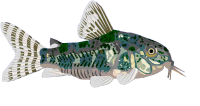Why is it so hard to find females sometimes??
-
davidkozak
- Posts: 305
- Joined: 19 Apr 2004, 20:53
- I've donated: $30.00!
- My images: 5
- Spotted: 3
- Location 2: Wpg
Why is it so hard to find females sometimes??
Sorry about the title-I realized how ridiculous it sounded after I typed it but couldn't think of anything better...
I've been waiting patiently for my local LFS to get some L260 in so I could get a couple more females...They got 10 in today, which seemed like quite a few to me(they usually only get a handful of each type of the more expensive plecos) After looking at the belly of each of them,(the only way I know of making an educated guess-females have no pattern on belly) only two were female and the rest were males....In another tank, they had some wild bristlenose that had just come in-they were 3-4 inches, therefore easily sexable--ALL MALES....
Do other people notice this at the LFS, or is it just my rotten luck that mine get's the bottom of the barrel from distributors??
david
I've been waiting patiently for my local LFS to get some L260 in so I could get a couple more females...They got 10 in today, which seemed like quite a few to me(they usually only get a handful of each type of the more expensive plecos) After looking at the belly of each of them,(the only way I know of making an educated guess-females have no pattern on belly) only two were female and the rest were males....In another tank, they had some wild bristlenose that had just come in-they were 3-4 inches, therefore easily sexable--ALL MALES....
Do other people notice this at the LFS, or is it just my rotten luck that mine get's the bottom of the barrel from distributors??
david
- sidguppy
- Posts: 3827
- Joined: 18 Jan 2004, 12:26
- My articles: 1
- My images: 28
- My aquaria list: 5 (i:0)
- Spotted: 9
- Location 1: Southern Netherlands near Belgium
- Location 2: Noord Brabant, Netherlands
- Interests: African catfishes and oddballs, Madagascar cichlids; stoner doom and heavy rock; old school choppers and riding them, fantasy novels, travelling and diving in the tropics and all things nature.
- Contact:
there's a few mechanisms at work here too.
first: many catchers believe that the "hairy ones" are a different species; when asked to catch "bristlenoses" they don't put in females.
second: there's a "trend" to keep people from breeding fish...the best way to accomplish this is to import/sell only one sex....bad practice, but it happens a LOT; famous examples are Betta macrostoma from Brunei, several Rainbowfish-species and ...L numbers.
third: many LFS aren't that smart either; they know their customers want "bristlenoses" so that's what they're going to sell to them.
I've seen the same thing happening over here too.
frustrating.
10 Rhineloricaria latirostris turned up in Belgium; only 2 females; guess who has then now!

first: many catchers believe that the "hairy ones" are a different species; when asked to catch "bristlenoses" they don't put in females.
second: there's a "trend" to keep people from breeding fish...the best way to accomplish this is to import/sell only one sex....bad practice, but it happens a LOT; famous examples are Betta macrostoma from Brunei, several Rainbowfish-species and ...L numbers.
third: many LFS aren't that smart either; they know their customers want "bristlenoses" so that's what they're going to sell to them.
I've seen the same thing happening over here too.
frustrating.
10 Rhineloricaria latirostris turned up in Belgium; only 2 females; guess who has then now!
Valar Morghulis
-
davidkozak
- Posts: 305
- Joined: 19 Apr 2004, 20:53
- I've donated: $30.00!
- My images: 5
- Spotted: 3
- Location 2: Wpg
- pturley
- Posts: 833
- Joined: 08 Jul 2003, 23:11
- I've donated: $66.00!
- My articles: 2
- My images: 16
- My cats species list: 1 (i:0, k:0)
- Spotted: 8
- Location 1: Cleveland, Ohio USA
One of the primary problems with Ancistrine plecos is, that from a fairly early age the males are more prone to hide in caves (caves that they may have had to fight for, and defend) and are therefore easier to catch than the females.
Females do hide in caves/driftwood snags but are much more likely to abandon it at the slightest disturbance and are thereby less likely to land in the fish catcher's nets.
Females do hide in caves/driftwood snags but are much more likely to abandon it at the slightest disturbance and are thereby less likely to land in the fish catcher's nets.
Sincerely,
Paul E. Turley
Paul E. Turley




